The Google Nexus 6P Review
by Andrei Frumusanu on December 16, 2015 8:00 AM ESTDisplay Measurement
One of the more significant characteristics of the Nexus 6P is the device’s AMOLED screen. Similar to last year’s Nexus 6, Google has chosen to employ the 6P with a panel from Samsung. While the Nexus 6’s panel seemed to lack in quality, both power and image quality wise, the 6P’s unit is quite excellent.
The screen is very clear and offers excellent homogeneity. Ever since the first AMOLED devices came out a few years ago Samsung has managed to steadily advance the technology with improvement with each yearly generation. The Nexus 6P’s can be said to rank well among the Note 4 or Note 5 in terms of image quality, and it seems the 6P’s lamination actually provides slightly better viewing angles than what’s found on Samsung’s devices.
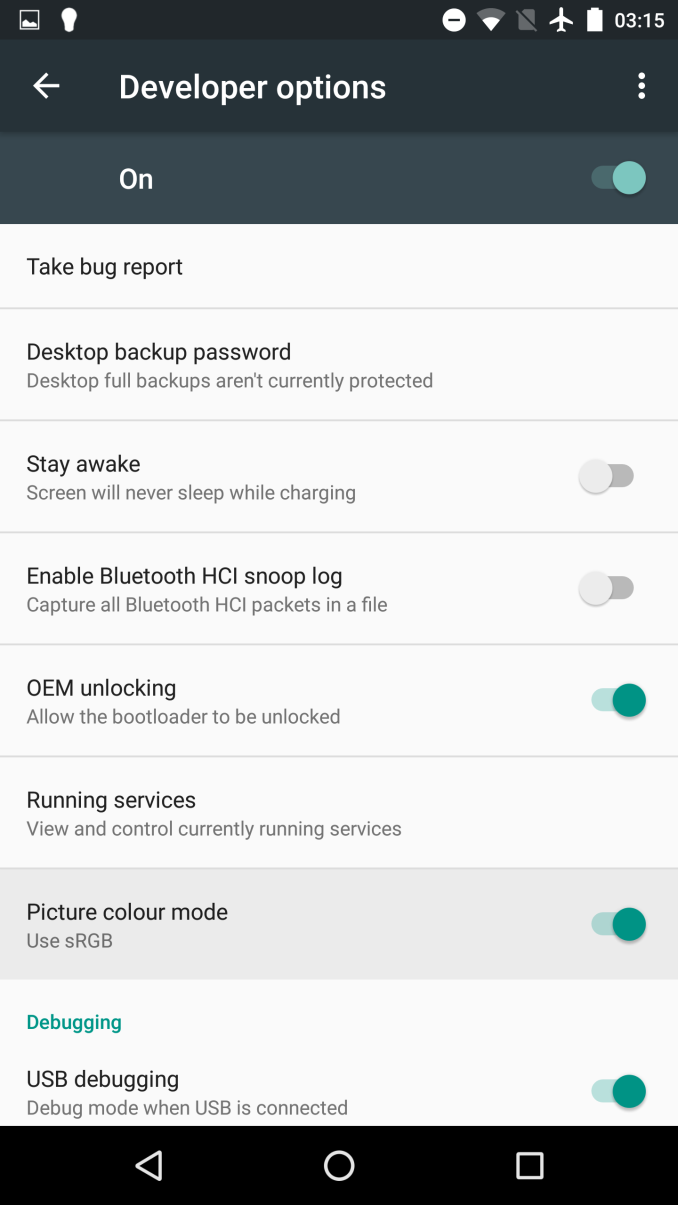
Settings => Developer Options => Picture Colour Mode
Before getting to the results, I'd like to mention that I tested both the device's default colour calibration as well as its sRGB calibration. This setting is rather hidden for the average user: You have to enable the developer options menu by tapping repeatedly on the "Build Number" found in Settings => About Phone, after which the menu will appear under the global settings menu. It's a pity that Google didn't make this option more accessible via the general display settings, but it will be required to access if you care about accurate colour reproduction on the Nexus 6P.
We start by measuring the maxium brightness of the 6P. As always, our display testing is done with an X-Rite i1Pro 2 spectrophotometer as our measurement hardware, in conjunction with SpectraCal's CalMAN software suite and our own workflow to be able to get an accurate display characterization.

The Nexus 6P manages to drive the screen at up to 348nits, a quite satisfactory level of brightness that matches the Note 5’s characteristics. Unlike Samsung’s devices, it seems the Nexus 6P has no overdrive function which vastly increases the luminosity under high ambient light and auto-brightness. Nevertheless, I’ve had no issues whatsoever in terms with outdoor visibility (Although that’s not a very convincing statement for European winters) as the screen offers excellent contrast.
While still on the topic of brightness, I was actually disappointed to discover that the device’s software is set up so that the brightness slider bottoms out at 8.5 cd/m². While doing the power curve measurements I discovered that the panel and driver is actually able to go down as low as 1.5 cd/m², making this one of the rare devices whose panel can go that low. I’ve become accustomed to using phones at around 2 nits at night and in bed, so 8 nits was suddenly brighter than I wished for. Changing the minimum value of the stock brightness slider wouldn’t be a very complicated task so I hope Google considers this for future maintenance releases.
Edit: After further testing I discovered that it's possible to get to 1.5 cd/m², but only if Adaptive Brightness is enabled and one is located in a dark environment, as brightness without AB offsets the range of the brightness slider.
Default:
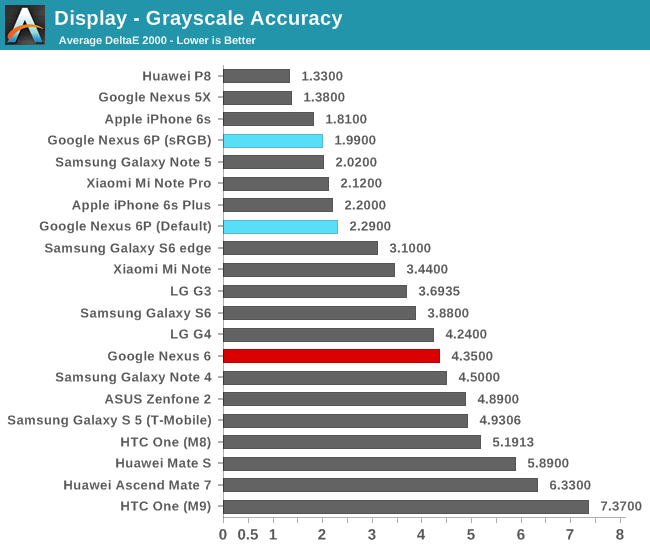
Moving on to the greyscale accuracy tests, we see the Nexus 6P behave very well. At a dE2000 of 1.99 the 6P lands as one of the best devices in terms of accurately reproducing greyscale content. There is however one problem, and that’s the average gamma of 2.41. This causes content to be darker than what it’s supposed to be and also has the effect of making colours seem more saturated. The default colour calibration doesn't differ very much from the calibrated sRGB norm, as it shows only a slight disadvantage with a dE2000 of 2.29.
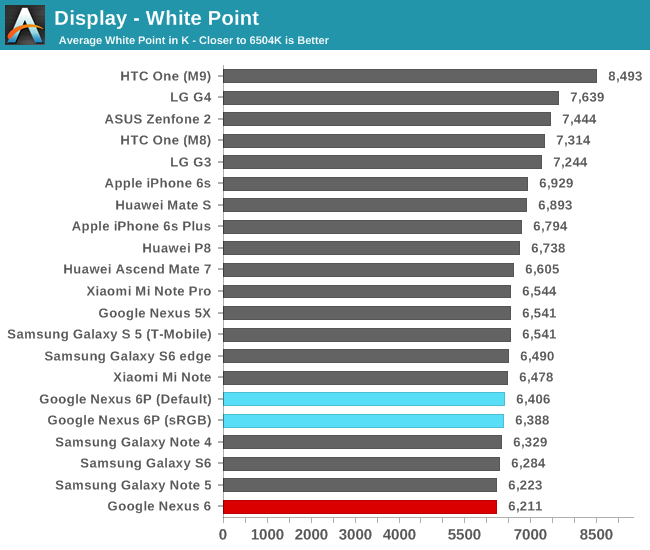
In terms of colour temperature, the 6P is slightly on the warm side as it comes at 6388K at 200cd/m². The latest generations of AMOLED screens seem for some reason to always slightly undershoot the target D65 (6500K) white, making the screen just slightly warmer than it should be.
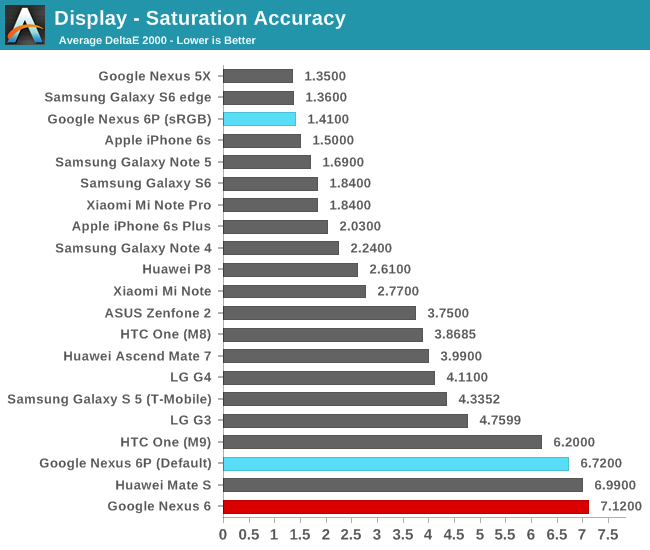
Moving on to the saturation accuracy measurements, we’re presented with some outstanding numbers from the sRGB mode as the 6P manages to deliver an excellent dE2000 of 1.41. At these accuracy levels I would argue that manufacturers would need to resort to individual device colour calibration to be able to provide even better results, as for example even by manually calibrating my own daily driver I wasn’t able to surpass a dE lower than 0.95. Unfortunately the default mode just fares little better than last year's Nexus 6, making for some very saturated colours. I tried to match the reproduced gamut against several standards but I didn't find anything that resembles the Nexus 6P's default mode, meaning this is not an AdobeRGB or DCI large gamut calibration.
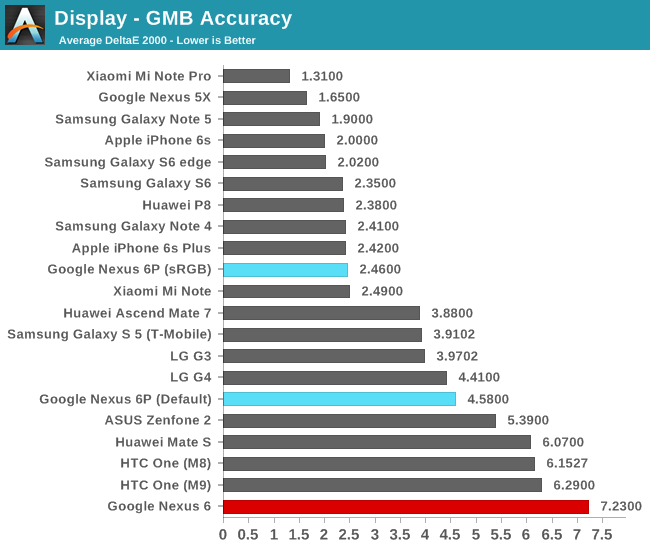
Moving onto the Gretag MacBeth set of commonly encountered colours we see the Nexus 6P fall behind when compared to its excellent greyscale or saturation results. Because the gamma on the 6P’s screen is too high, it causes the luminosity component of colours to be lower and thus, as can be seen in our comparison strip, they will appear darker and slightly more saturated than they should.
On the default settings the GMB accuracy is farther off as expected. There's not much to say here as it's a deliberately inaccurate mode that gives higher priority to vibrant colours as opposed to accuracy.
Overall the Nexus 6 screen ranks among one of the best. It’s a bit of a pity that the gamma calibration was slightly off under the sRGB profile but otherwise the 6P excels in all other metrics. Samsung currently offers the best quality displays and Google and the Nexus 6P takes full advantage of that fact.
Display Power
While we can safely declare that the Nexus 6P offers excellent image quality in its display, one aspect that hasn’t been characterised as much in the past was the power consumption and the resulting luminance efficiency. The Nexus 6 suffered from a quite inefficient panel that resulted in a battery runtime that was lower than expected from a device of its configuration. I was quite worried when I saw that Huawei chose a quite inefficient AMOLED screen for the Mate S, as that proved to be a double-edged sword for the device, as it also offered great image quality but at a great cost in power efficiency.
For the Nexus 6P, getting an accurate power curve for the screen was exceptionally hard as the fuel-gauge of the PMI8994 power management IC of Snapdragon 810 devices updates only rarely and therefor becomes unusable for many power measurements. So to properly characterize the power draw at increasing brightness without spending several hours for each measurement point I hooked up my measurement equipment to the USB power of the 6P. Once a phone’s battery cell is fully charged it will usually switch to be fully powered by the power supplied by the connector as long as it’s able to provide sufficient power. The downside of this method is there’s a significant unknown delta due to the inefficiency of the PMIC converting the input 5V to the system’s internal 3.3V. Nevertheless with some help of some test measurements via the internal fuel gauge I was able to compensate for this difference, which gives us the following power curve:
The Nexus 6P seems to have a base power consumption of around 450mW with a fully black screen, meaning no pixels are powered. This comes in to be similar to what we’ve measured on the Note 4 Exynos, but is still about ~100mW higher than devices featuring more efficient SoC platforms. At maximum brightness, the device consumes about 1.59W, a tad under the 1.7W that the Note 4 used. Some readers might already figure out where I want to go with this, as there’s been plenty of discussion and questions in regard to the efficiency of the panel that will be employed on the Nexus 6P.
To get a better overview, we plot the screen luminance power across several devices in a table and calculate the overall efficiency by dividing that figure by the screen’s area footprint. As a reminder, the screen luminance power is the delta between a screen’s black (or minimal brightness) power to full white at a given brightness, in this case 200cd/m².
| Screen Luminance Power Efficiency 100% APL / White |
||||||
| Device | Screen Luminance Power at 200cd/m² |
Luminance Power (mW) / Screen area (cm²) Efficiency |
||||
| LG G4 | 354 mW | 4.11 | ||||
| Meizu MX4 | 345 mW | 4.14 | ||||
| Huawei P8 | ~341 mW | ~4.43 | ||||
| Meizu MX4 Pro | 386 mW | 4.47 | ||||
| Samsung Galaxy Note 5 | 504 mW | 5.64 | ||||
| Samsung Galaxy S6 | 442 mW | 5.99 | ||||
| Huawei Nexus 6P | ~615 mW | ~6.88 | ||||
| Samsung Galaxy S5 | 532 mW | 7.21 | ||||
| Samsung Galaxy Note 4 | 665 mW | 7.22 | ||||
| Samsung Galaxy S5 LTEA | 605 mW | 8.20 | ||||
| LG Flex 2 | 765 mW | 8.89 | ||||
| Samsung Galaxy S4 | 653 mW | 9.22 | ||||
| Huawei Mate S | ~769 mW | ~9.24 | ||||
At a 200nits and a luminance power of around 615mW, the Nexus 6P’s panel falls in between the Note 4 and the Note 5’s/Galaxy S6’s in terms of efficiency. We can’t clearly attribute any certain emitter generation to the device, but it looks to be about 5% more efficient than the Note 4’s but still a considerable 16% less efficient than the Note 5. It was starting with the Galaxy S6 that I’ve considered AMOLED screens to no longer be in at a disadvantage to LCDs when it comes to efficiency in every-day use-cases. Since the Nexus 6P falls behind that it means we should expect slightly less run-time than comparable LCD devices. Let’s continue on to the battery life results to verify this assessment.






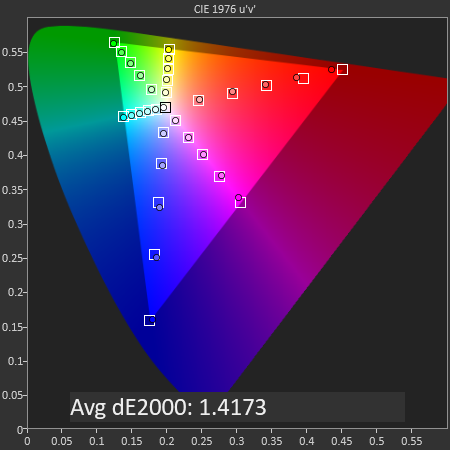
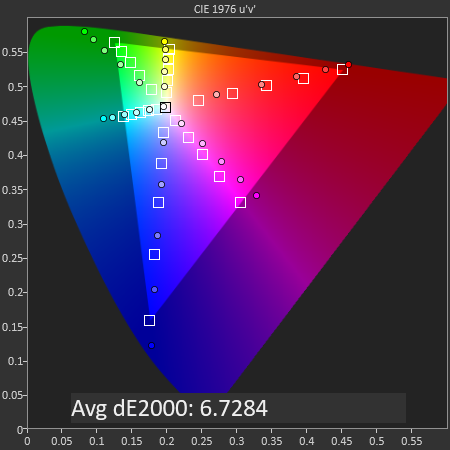

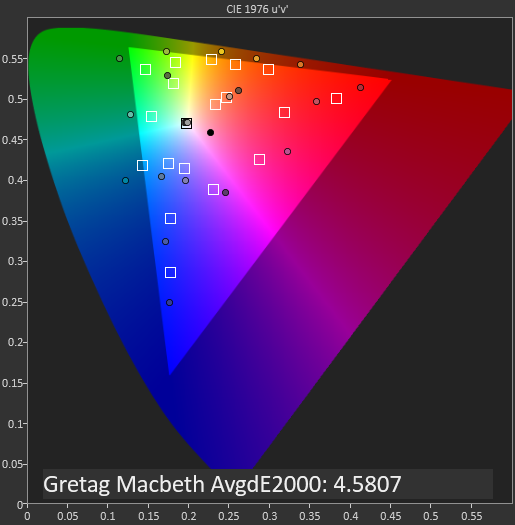


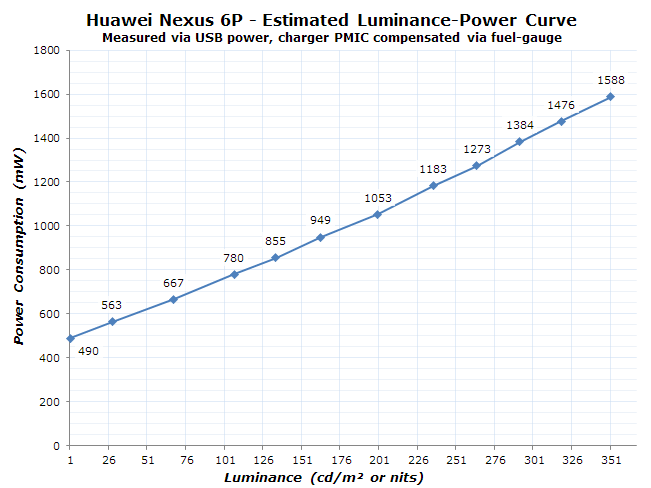








219 Comments
View All Comments
Djdjndjddjs - Wednesday, December 16, 2015 - link
"even last year’s Snapdragon 801/805 phones" this here just made this review a whole lot less credible.grayson_carr - Thursday, December 17, 2015 - link
How so? He was referring to sustained performance (after throttling) and the Nexus 6P does indeed have a lower framerate than the One M8 (Snapdragon 801) in the GFXBench Sustained Performance test.tuxRoller - Wednesday, December 16, 2015 - link
So, the 6p does a better job than the note 5 at maintaining long-term graphics perf.grayson_carr - Thursday, December 17, 2015 - link
Looks like it. Weird that the Galaxy S6 did a better job than both though. You would think the Note 5 would do better than the S6... same SOC, but seemingly more room to dissipate heat.Sahrin - Wednesday, December 16, 2015 - link
Really important to see the carrier aggregation information for the radio as well, not just the band supported.bmullan - Wednesday, December 16, 2015 - link
The article was TLDR ... but in case the article didn't mention it.... These are the 2 Phones that Google has approved for its Project FI (https://fi.google.com/about/).The Nexus 6P is the one to get if you want to have the transparent auto-switching between 2 different Mobile Providers and also auto-switching with wifi. The Nexus 6 only gets you transparent auto-switching between 1 mobile provider & wifi.
rstuart - Wednesday, December 16, 2015 - link
I bought a 6P a while ago, so I read the article more to get a feel for how well it matches my own thoughts about the phone.Overall, it does. Even it's comments on price are pretty well spot on - I live outside of the US, and if I had to pay for it there is no way I could justify it, even though I happen to prefer stock Android.
I was particularly pleased to see how Qualcomm's clusterfuck, the 810 was presented. There is simply no excuse for producing a SoC that is worse than the previous generation in terms of performance/watt, and yet that is what Quallcomm did. Yet amazingly, Huawei (mostly through the large battery) and Google (using software tricks to keep the thing switched off) managed to mitigate that and produce a device that has a very usable battery life.
Subjectively in everyday use the 6P is very fast, just as the review says. And yes the screen is excellent, although it would be just as good if they dropped the resolution by 1/3 to retina levels and reduced the load off the GPU. The form fact is perfect for a phablet - the screen is large but you can still comfortably operate it with one hand. (Hint Andrei: that is why the buttons are in the middle. You could not reach them if they were on the top. And yes, making them reachable when you pick it up with one hand also means you bump them occasionally.)
It's a pity Andrei didn't comment on USB-C. I make a point of handing the phone plus USB-C cable over to people and you can hear an audible sigh of joy from some as they realise the mental effort of orientating the connect has gone. The connector with its definite click as you push it home is a delight to use. And he neither does he mention the down side - USB-C to traditional USB adaptors is a mess, and as a result you can forget getting those excellent charging results from any of your non USB-C chargers. Instead you get the base rate of 0.5A 5V charging regardless of what your charger is capable of, which means when I'm using the phone for navigation in the car the battery discharges even though plugged in. And there is no wireless charging.
My overall feeling is it is a wonderful phone, the occasional wart doesn't harm the experience. Amazing, given given the clusterfuck of a SoC Huawei and Google had to work with. Still, if I was in a position to wait 12 months I'd be waiting. The 820 is not only back on trend in the performance/watt stakes, it also has a much better LTE modem and it looks like those extra LTE bands international version has is what took the price from "reasonable" to "badly overpriced".
silverblue - Thursday, December 17, 2015 - link
My upgrade is due next Wednesday, and I've been looking at this phone with more than a passing interest, however one or two sites out of the (very happy, I might add) maddening crowd don't appear to be too complimentary about it. We've got a 950 XL here for testing so I'm waiting for more news on that despite the slagging off it's been getting from the press, and I suppose I don't have to upgrade on the deadline day, however there is the small matter of a free £50 Google Play voucher until the 24th which makes it all the more tempting. Additionally, whereas the Note 5 would seem like a good alternative, I'm hearing a lot made about its availability and price, plus Samsung's incessant desire to tell you that their vision of Android is the correct one, and the aforementioned memory management issue, so I'm not considering the Note 5 at this time. Had this review been more positive, I think my mind would've been made up.I could always just wait another month. January sales, and all that.
silverblue - Thursday, December 17, 2015 - link
Of course, the voucher is applicable to the 6P. :) There's also the small matter of the non-availability of the free dock on the 950 series, but then again, it's not as if I'm going to use a phone to do all my work on.grayson_carr - Thursday, December 17, 2015 - link
Your point about only getting the base rate of 0.5A from non USB-C chargers is not correct. Using an Anker charger in my care with the USB A to C cable from the Google Store gets me near 2A, which isn't as fast as the 3A provided by the USB C charger included in the box, but is still fairly fast.